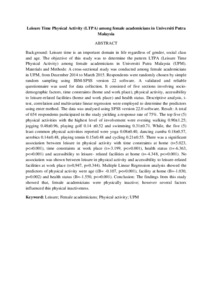Citation
Mahmud, Z. Y. and Minhat, Halimatus Sakdiah and Mahmud, Aidalina
(2016)
Leisure Time Physical Activity (LTPA) among female academicians in Universiti Putra Malaysia.
International Journal of Public Health and Clinical Sciences, 3 (1).
pp. 83-95.
ISSN 2289-7577
Abstract
Background: Leisure time is an important domain in life regardless of gender, social class and age. The objective of this study was to determine the pattern LTPA (Leisure Time Physical Activity) among female academicians in Universiti Putra Malaysia (UPM). Materials and Methods: A cross-sectional study was conducted among female academicians in UPM, from December 2014 to March 2015. Respondents were randomly chosen by simple random sampling using IBM-SPSS version 22 software. A validated and reliable questionnaire was used for data collection. It consisted of five sections involving socio-demographic factors, time constraints (home and work place), physical activity, accessibility to leisure-related facilities (home and work place) and health status. Descriptive analysis, t-test, correlation and multivariate linear regression were employed to determine the predictors using enter method. The data was analysed using SPSS version 22.0 software. Result: A total of 654 respondents participated in the study yielding a response rate of 75%. The top five (5) physical activities with the highest level of involvement were evening walking 0.90±1.25; jogging 0.48±0.96, playing golf 0.14 ±0.52 and swimming 0.31±0.71. While, the five (5) least common physical activities reported were yoga 0.08±0.40, dancing zumba 0.18±0.57, aerobics 0.14±0.48, playing tennis 0.15±0.48 and cycling 0.21±0.55. There was a significant association between leisure in physical activity with time constraints at home (t=5.023, p<=0.001), time constraints at work place (t=-3.199, p<=0.001), health status (t=-6.363, p<=0.001) and accessibility to leisure- related facilities at home (t=-4.348, p<=0.001). No association was shown between leisure in physical activity and accessibility to leisure-related facilities at work place (t=0,947, p=0.344). Multiple Linear Regression analysis showed the predictors of physical activity were age ((B= -0.107, p<=0.001), facility at home (B=-1.030, p=0.002) and health status (B=-1.550, p<=0.001). Conclusion: The findings from this study showed that, female academicians were physically inactive; however several factors influenced this physical inactiveness.
Download File
![[img]](http://psasir.upm.edu.my/54707/1.hassmallThumbnailVersion/Leisure%20Time%20Physical%20Activity%20%28LTPA%29%20among%20female%20academicians%20in%20Universiti%20Putra%20Malaysia.pdf)  Preview |
|
Text
Leisure Time Physical Activity (LTPA) among female academicians in Universiti Putra Malaysia.pdf
Download (7kB)
| Preview
|
|
Additional Metadata
Actions (login required)
 |
View Item |

